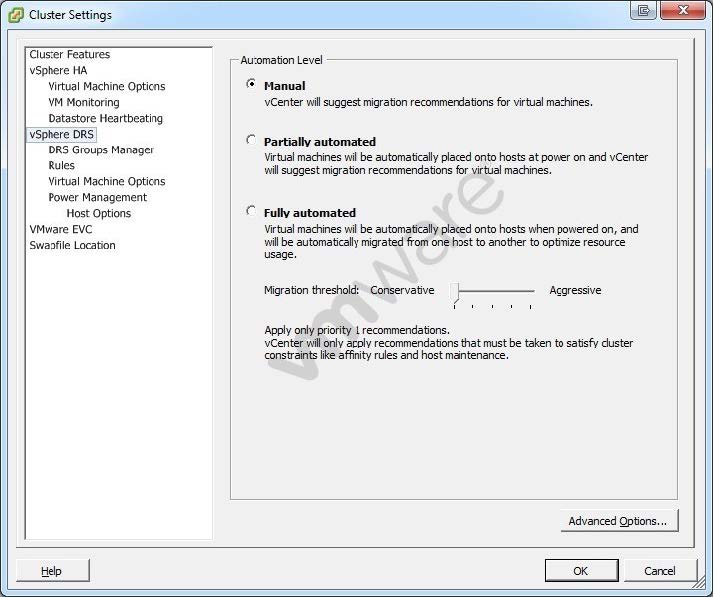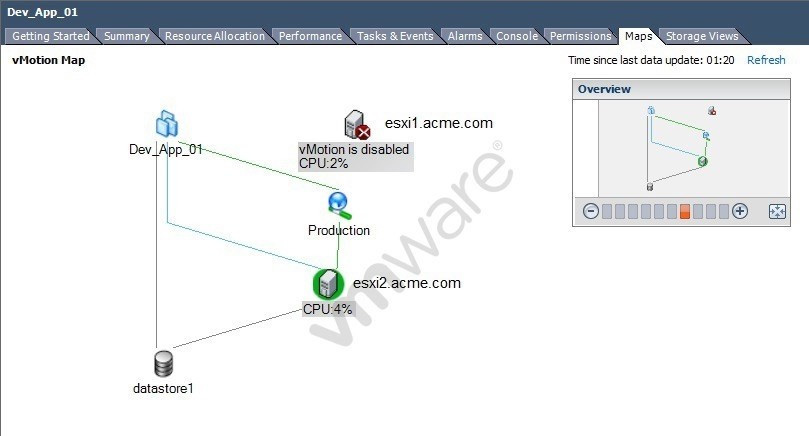Exam Details
Exam Code
:VCP5-DCVExam Name
:VMware Certified Professional 5 - Data Center Virtualization (VCP5-DCV)Certification
:VMware CertificationsVendor
:VMwareTotal Questions
:571 Q&AsLast Updated
:Dec 21, 2024
VMware VMware Certifications VCP5-DCV Questions & Answers
-
Question 301:
Select three of the steps for configuring iSCSI Software Initiator multipathing when load balancing with a single vSphere standard switch. (Choose three.)
A. Change the Path Selection Policy to Round Robin (VMware)
B. Enable Override switch failover order
C. Enable Route based on IP Hash
D. Enable iSCSI port binding on the VMkernel object or objects
E. Add VMkernel adapters to the iSCSI Network Configuration
-
Question 302:
An administrator is configuring Storage DRS in their environment. The Datastore cluster is composed of 4 VMFS3 volumes and 9 VMFS5 volumes. Storage DRS has been enabled, but is showing as disabled on several virtual machine disks in the datastore cluster.
Which two conditions would cause this error to occur? (Choose two.)
A. The virtual machine is stored on a VMFS 3 volume.
B. One or more virtual machines have Persistent disks.
C. The virtual machine is stored on a NFS datastore.
D. The virtual machine is stored on a datastore with a 2mb block size.
-
Question 303:
Click the Exhibit button.

An administrator is applying patches to a batch of ESXi 5.x hosts in an under-allocated HA/DRS cluster. An attempt is made to place the host into maintenance mode, but the progress has stalled at 2%. DRS is configured as shown in the exhibit. Of the four choices below, two would effectively resolve this issue. Which two steps could be taken to correct the problem? (Choose two.)
A. Enable VMware EVC.
B. Set the virtual machines on the host to Fully Automated.
C. Shut down the virtual machines on the host.
D. Move the virtual machine swap file off the local datastore.
-
Question 304:
Click the Exhibit button.

An administrator has a DRS/HA cluster with five ESXi 5.x hosts. When the administrator tries to start a new Web server virtual machine, an error is displayed saying insufficient resources exist for HA. Based on the HA configuration in the exhibit, which two changes can resolve the issue? (Choose two.)
A. Shut down one or more virtual machines on the cluster.
B. Set VM Restart Priority to Disabled for the Web server.
C. Set Host Isolation response to Shut down.
D. Suspend one or more virtual machines in the cluster.
-
Question 305:
Which two circumstances might cause a DRS cluster to become invalid? (Choose two.)
A. DRS has been disabled on one or more ESXi hosts.
B. An ESXi host has been removed from the cluster.
C. A migration on a virtual machine is attempted while the virtual machine is failing over.
D. Virtual machines have been powered on from a vSphere Client connected directly to an ESXi host.
-
Question 306:
Click the Exhibit button.

An administrator is configuring vMotion in their environment. As part of the implementation, an administrator is examining resource mapping for virtual machines. What is a likely cause of the error shown in the exhibit?
A. vMotion has been disabled because the are no other hosts in the cluster with vMotion enabled.
B. vMotion has not been enabled on the Production port group.
C. The administrator has not created a Managent network.
D. vMotion has not been enabled on a VMkernel port group.
-
Question 307:
An administrator is unable to connect a vSphere Client to an ESXi 5.x host. Which option can be selected from the direct console to restore connectivity without disrupting running virtual machines?
A. Restore the Standard Switch from the ESXi host.
B. Restart the Management Agents from the vSphere client.
C. Restart the Management Agent from the ESXi host
D. Disable the Management Network from the vSphere client.
-
Question 308:
A user attempts a remote SSH connection to a newly-installed ESXi 5.x host to execute some commands. The SSH connection attempt fails, though the user is able to receive a ICMP ping back from the host. What must the administrator do to enable SSH? (Choose two.)
A. Enable root logon on the ESXi server.
B. Open the SSH port on the ESXi firewall.
C. Start the SSH service on the ESXi server.
D. Create a local user on the ESXi server.
-
Question 309:
An administrator is setting up vMotion in a vSphere environment. A migration is run to test the configuration, but fails. What could the administrator do to resolve the issue?
A. Ensure the VMkernel port group is configured for Management Traffic.
B. Enable VMkernel port group for the vSphere cluster.
C. Ensure the vMotion enabled adaptors configured for the same subnet.
D. Use a vDS instead of a standard switch.
-
Question 310:
A vSphere 5 implementation consists of a fully automated DRS cluster with two ESXi 5.x hosts with the following vSphere Standard Switch configuration:
1.
Switch A. three vmnics, one port group named sFTP-PG
2.
Switch B. two vmnic, one port group named Web-PG
3.
All vmnics are trunked to the same physical switch.
DRS has been configured with an anti-affinity rule for all virtual machines in the Web-PG so that no more than half of the virtual machines run on any given host. The virtual machines on WebPG are experiencing significant network latency.
The network team has determined that a performance bottleneck is occurring at the ESXi host level.
Which solution will require the least amount of administrative work and the least amount of service interruption?
A. Migrate Web-PG to Switch A and sFTP-PG to Switch B on each host
B. Move a vmnic from Switch A to Switch B on each host
C. Convert the three Switch Bs to a single vSphere Distributed Switch
D. Use vMotion to redistribute some of the VMs in Web-PG to a different ESXi host
Related Exams:
1V0-21.20
Associate VMware Data Center Virtualization1V0-31.21
Associate VMware Cloud Management and Automation1V0-41.20
Associate VMware Network Virtualization1V0-61.21
Associate VMware Digital Workspace1V0-71.21
Associate VMware Application Modernization1V0-81.20
Associate VMware Security2V0-21.20
Professional VMware vSphere 7.x2V0-21.23
VMware vSphere 8.x Professional2V0-31.21
Professional VMware vRealize Automation 8.32V0-31.23
VMware Aria Automation 8.10 Professional
Tips on How to Prepare for the Exams
Nowadays, the certification exams become more and more important and required by more and more enterprises when applying for a job. But how to prepare for the exam effectively? How to prepare for the exam in a short time with less efforts? How to get a ideal result and how to find the most reliable resources? Here on Vcedump.com, you will find all the answers. Vcedump.com provide not only VMware exam questions, answers and explanations but also complete assistance on your exam preparation and certification application. If you are confused on your VCP5-DCV exam preparations and VMware certification application, do not hesitate to visit our Vcedump.com to find your solutions here.